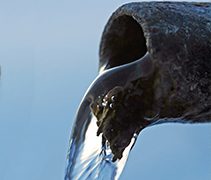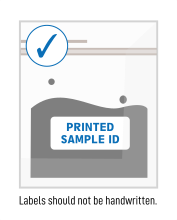
Note – Fees are inclusive of δ13C measurements, quality assurance reports, and 24/7 web access to past results and pending analyses. DOC extraction fee applies in addition to the standard price.
Results – Reports are available in English only.
 We are a NATURAL Level carbon-14 testing laboratory and cannot accept water samples that have been collected from any area that is near nuclear power plants, commercial or medical reactors, or industrial/medical waste disposal sites, or from within their drainage areas. The water samples must not be stored or handled in any laboratory or area that uses OR has ever been used in a biomedical facility with artificially labeled carbon-14 at any time.
We are a NATURAL Level carbon-14 testing laboratory and cannot accept water samples that have been collected from any area that is near nuclear power plants, commercial or medical reactors, or industrial/medical waste disposal sites, or from within their drainage areas. The water samples must not be stored or handled in any laboratory or area that uses OR has ever been used in a biomedical facility with artificially labeled carbon-14 at any time.
Should you suspect that your samples may in any way have elevated carbon-14 activities above peak Bomb Carbon levels (~200 pMC / 2.0 F14C), please DO NOT send the samples for testing. Water samples that produce activities above 200 pMC will incur extensive costs related to any cleanup necessary, equipment replacement, and duplicate analyses required for other samples. These costs could easily run into the tens of thousands of dollars, which you will be responsible for as the submitter.
Thoroughly flush the bottle with the sample water at least 3 times before collecting the final sample with the aid of a water filter. Use a filter with pore sizes at 0.7 μm or below. If samples are not filtered, the 14DOC signature is at risk of changing while the samples are in transit.
Fill the bottle with little to no headspace.
If samples are to be stored for any length of time, they must be refrigerated between 3-5 ˚C (37-41˚F). Beware that glass bottles containing the water sample may crack if they are frozen.
Seal the space between the bottle and the cap with parafilm or electrical/duct tape to prevent carbon dioxide (CO2) exchange with the atmosphere during shipment.
Samples should be sent chilled or cold (NOT frozen). Long-lasting ice packs (i.e. cooler ice packs, cooler shock, or ice block) work well for this purpose; they will help ensure that the water samples maintain low temperature conditions while in transit to our testing laboratory
Before placing them into a cooler or cardboard box, the bottles should be placed inside a plastic bag and sealed. Please use shipping containers with enough packing material to prevent breakage.
NOTE: Beta Analytic WILL NOT return water samples, bottles, or coolers.
Customers must a commercial courier or registered first-class mail when sending samples to the lab. Please send an email with the courier's name and tracking number so we can monitor your package
Dissolved organic carbon (DOC) is the largest pool of organic matter and reduced carbon in the oceans, roughly equal in size to CO2 in the atmosphere (Beaupré 2007). DOC is also found in terrestrial ecosystems and plays an important role in the global carbon cycle, partially due to its ability to transport carbon between different pools in the ecosystem (Kolka 2008). DOC can be sourced from outside the ecosystem (atmospheric carbon, long distance transport) or within the ecosystem (from plants/microbes or soils/sediments), and higher levels of organic material are not uncommon in environments with lower oxygen levels such as swamps (Bruckner 2016).
The measurement of radiocarbon in DOC is a useful tool for identifying changes in the sources and cycling processes of natural waters, both in freshwater and marine water systems when monitored over time (Xue 2015, Xu 2021).
DOC is most useful when combined with additional information, such as δ13C measurements or other stable isotope measurements from nutrients such as phosphate or nitrate. This is due to the role of DOC in nutrient cycling and its availability in ecosystems.
Along with other nutrients present in the ecosystem, radiocarbon and stable isotope measurements of DOC allow for a more complete picture of an ecosystem's health. When samples are collected along a transect in a watershed, agricultural area, etc., the data can be used to quantify contributions to the DOC pool from both old and modern carbon sources, determine water quality, and ultimately determine the impact on a particular ecosystem (Stern 2007).
References:
Recommended Literature:
SGS Beta is merely facilitating these literature recommendations as a resource to the community. The company and the services we offer do not have any relationship or endorsement to those research or methods referred to in the recommended literature below.
Darling, W. G., et al. Using environmental tracers to evaluate the preservation of palaeoclimate signals in aquifers of the London Basin, UK. Journal of Hydrology, 2023, 617, 128972
Heine, F. & Einsiedl, F. Groundwater dating with dissolved organic radiocarbon: A promising approach in carbonate aquifers. Applied Geochemistry, 2021, 125, 104827
Godfrey, L., et al. δ13C and 14C activity of groundwater DOC and DIC in the volcanically active and arid Loa Basin of northern Chile. Journal of Hydrology, 2021, 595, 125987
Please fill out the form to download our shipping guidelines for radiocarbon analysis of Water DOC
Page last updated: December 2025